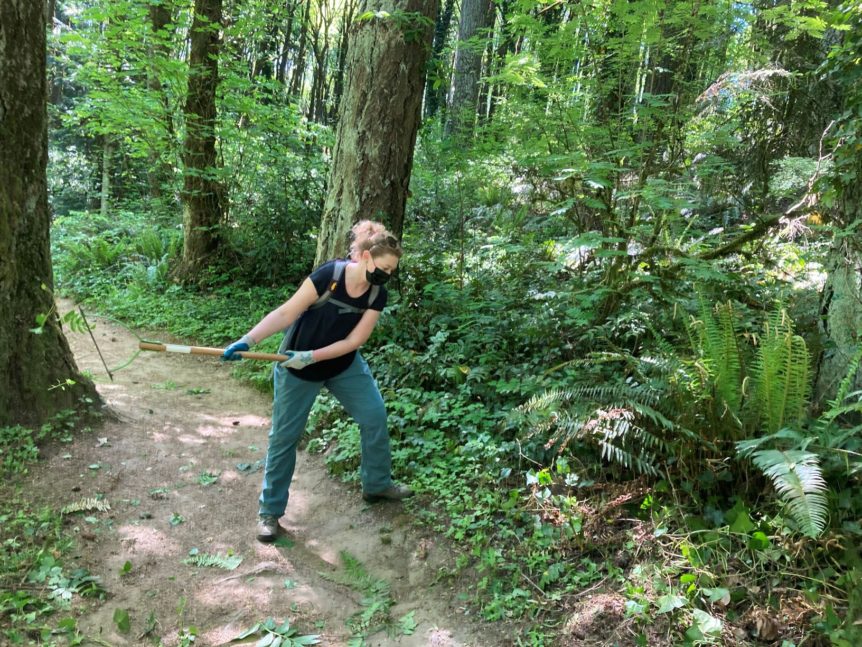Forest Park Conservancy is responsible for brushing a total of 40.45 miles of soft-surface trails within Forest Park every year. Brushing is a key aspect of the maintenance efforts FPC conducts every year. But, what is brushing, and why is it so important?
Trail maintenance efforts often are context-dependent. The nature of a forest, its ecology, climate, foot traffic, and more can all affect what is necessary to keep the forest healthy and maintain it for the use of its patrons. Brushing is one such necessity in Forest Park. Brushing is the maintenance act of removing debris and excess vegetation from the sides of the trails, up to two feet on the uphill sides of trails and one foot on the downhill side.
Now brushing might not sound like an important task at first; the removal of plants and leaf litter and such might seem unnecessary. After all, those materials are naturally occurring so why would they necessitate removal? Well, to find out I reached out to FPC’s Trails and Restoration Manager Ahmed Yusuf for some information. Ahmed explained to me that there are a number of reasons that make brushing the trails necessary.
1.) Improving Trail Access
Firstly, for Forest Park’s visitors, brushing the sides of the trails allows for more room for people to have clear paths to walk and makes the trails more accessible. Without brushing, vegetation would creep onto and cover the trails people use for recreation. Creating a buffer area around the trails also allows for people to have extra space to walk. Given that the trails are one of Forest Park’s most used features, extra walking space also helps mitigate barriers to usage due to accessibility.
2.) Preventing Erosion from “Social Trails”
In addition, when the trails aren’t managed to have a proper amount of space or kept clear people might begin to “make their own paths” in order to go through the forest. What happens is people begin to clear their own way into the forest when trails aren’t available by pushing down vegetation to create a path. However, over time other people will use this informal trail as proper ones are not available, further compressing that area and causing soil erosion due to concentrated foot traffic. So keeping the trails clear serves as an effective means of mitigating erosion.
3.) Preventing Burms and Water Damage
Another cause of erosion trail brushing prevents is the formation of burms, spaces where the slope levels out due to erosion. Burms can be formed by water runoff channeled into a section of forest by vegetation and debris, preventing the water from flowing downhill. This concentration of water then levels out the slope over time forming a burm. When the trails are brushed water can freely flow downhill, minimizing erosion due to non-flowing water.
Get Involved!
Every year the goal is to brush all 40.45 miles of trail in the time span of May through July. However, even with the help of community volunteer crews, this is a hard task. Not only does every trail need to be brushed but some trails that get more direct sunlight might require a second brushing due to faster plant growth that threatens to encroach on the trails. The Forest Park Conservancy community of volunteers help make this daunting task possible.
If you enjoy using Forest Park and would like to give back and help make the park accessible for the community, consider joining a works party to help give FPC a hand! We are hosting our first annual Brush-A-Thon this Saturday and would love to have your help! Click here to sign up.
Or, check out the full FPC events calendar to find one of our weekly trails works party events that you can sign up for to help keep the park available for everyone to use.

